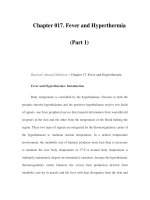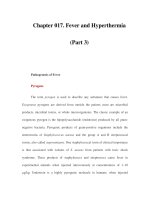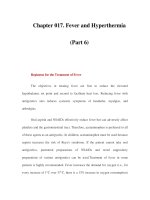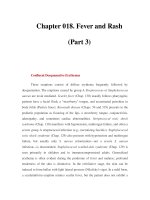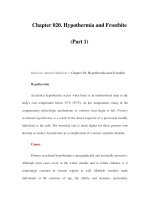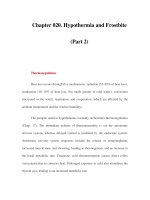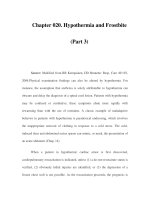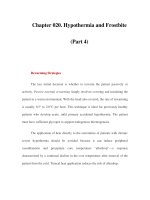Chapter 020. Hypothermia and Frostbite (Part 3) doc
Bạn đang xem bản rút gọn của tài liệu. Xem và tải ngay bản đầy đủ của tài liệu tại đây (14.01 KB, 5 trang )
Chapter 020. Hypothermia and Frostbite
(Part 3)
Source: Modified from RR Kempainen, DD Brunette: Resp. Care 49:192,
2004.Physical examination findings can also be altered by hypothermia. For
instance, the assumption that areflexia is solely attributable to hypothermia can
obscure and delay the diagnosis of a spinal cord lesion. Patients with hypothermia
may be confused or combative; these symptoms abate more rapidly with
rewarming than with the use of restraints. A classic example of maladaptive
behavior in patients with hypothermia is paradoxical undressing, which involves
the inappropriate removal of clothing in response to a cold stress. The cold-
induced ileus and abdominal rectus spasm can mimic, or mask, the presentation of
an acute abdomen (Chap. 14).
When a patient in hypothermic cardiac arrest is first discovered,
cardiopulmonary resuscitation is indicated, unless (1) a do-not-resuscitate status is
verified, (2) obviously lethal injuries are identified, or (3) the depression of a
frozen chest wall is not possible. As the resuscitation proceeds, the prognosis is
grave if there is evidence of widespread cell lysis, as reflected by potassium levels
> 10 mmol/L (10 meq/L). Other findings that may preclude continuing
resuscitation include a core temperature < 10–12°C, a pH < 6.5, or evidence of
intravascular thrombosis with a fibrinogen value < 0.5 g/L (<50 mg/dL). The
decision to terminate resuscitation before rewarming the patient past 33°C should
be predicated on the type and severity of the precipitants of hypothermia. There
are no validated prognostic indicators for recovery from hypothermia. A history of
asphyxia with secondary cooling is the most important negative predictor of
survival.
Diagnosis and Stabilization
Hypothermia is confirmed by measuring the core temperature, preferably at
two sites. Rectal probes should be placed to a depth of 15 cm and not adjacent to
cold feces. A simultaneous esophageal probe should be placed 24 cm below the
larynx; it may read falsely high during heated inhalation therapy. Relying solely
on infrared tympanic thermography is not advisable.
After a diagnosis of hypothermia is established, cardiac monitoring should
be instituted, along with attempts to limit further heat loss. If the patient is in
ventricular fibrillation, one defibrillation attempt (2 J/kg) should be administered.
If the rhythm does not convert, rewarm the patient to 30–32°C before repeating
defibrillation attempts. Supplemental oxygenation is always warranted, since
tissue oxygenation is adversely affected by the leftward shift of the
oxyhemoglobin dissociation curve. Pulse oximetry may be unreliable in patients
with vasoconstriction. If protective airway reflexes are absent, gentle endotracheal
intubation should be performed. Adequate pre-oxygenation will prevent
ventricular arrhythmias. Although cardiac pacing for hypothermic
bradydysrhythmias is rarely indicated, the transthoracic technique is preferable.
Insertion of a gastric tube prevents dilatation secondary to decreased bowel
motility. Indwelling bladder catheters facilitate monitoring of cold-induced
diuresis. Dehydration is commonly encountered with chronic hypothermia, and
most patients benefit from a bolus of crystalloid. Normal saline is preferable to
lactated Ringer's solution, as the liver in hypothermic patients inefficiently
metabolizes lactate. The placement of a pulmonary artery catheter risks
perforation of the less compliant pulmonary artery. Insertion of a central venous
catheter into the cold right atrium should be avoided, since this can precipitate
arrhythmias.
Arterial blood gases should not be corrected for temperature (Chap. 48). An
uncorrected pH of 7.42 and a P
CO2
of 40 mmHg reflects appropriate alveolar
ventilation and acid-base balance at any core temperature. Acid-base imbalances
should be corrected gradually, since the bicarbonate buffering system is
inefficient. A common error is overzealous hyperventilation in the setting of
depressed CO
2
production. When the P
CO2
decreases 10 mmHg at 28°C, it doubles
the pH increase of 0.08 that occurs at 37°C.
The severity of anemia may be underestimated because the hematocrit
increases 2% for each 1°C drop in temperature. White blood cell sequestration and
bone marrow suppression are common, potentially masking an infection.
Although hypokalemia is more common in chronic hypothermia,
hyperkalemia also occurs; the expected electrocardiographic changes can be
obscured by hypothermia. Patients with renal insufficiency, metabolic acidoses, or
rhabdomyolysis are at greatest risk for electrolyte disturbances.
Coagulopathies are common because cold inhibits the enzymatic reactions
required for activation of the intrinsic cascade. In addition, thromboxane B
2
production by platelets is temperature-dependent, and platelet function is
impaired.
The administration of platelets and fresh frozen plasma is, therefore, not
effective. The prothrombin or partial thromboplastin times or INR (international
normalized ratio) reported by the laboratory appear deceptively normal and
contrast with the observed in vivo coagulopathy. This contradiction occurs
because all coagulation tests are routinely performed at 37°C, and the enzymes are
thus rewarmed.
